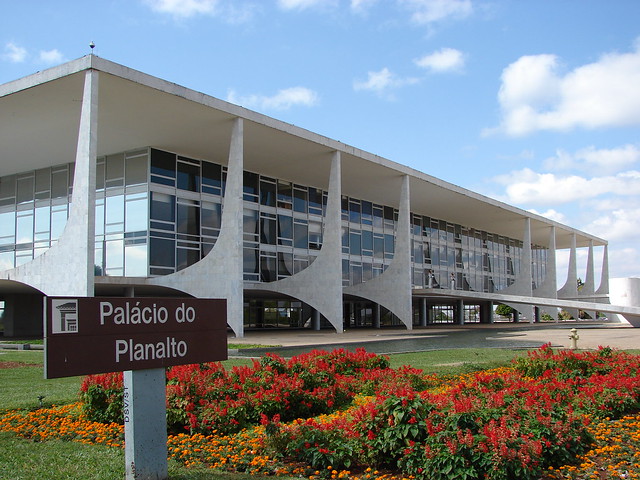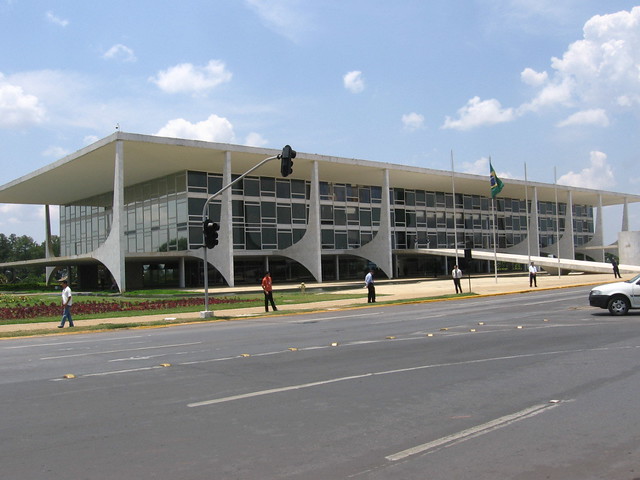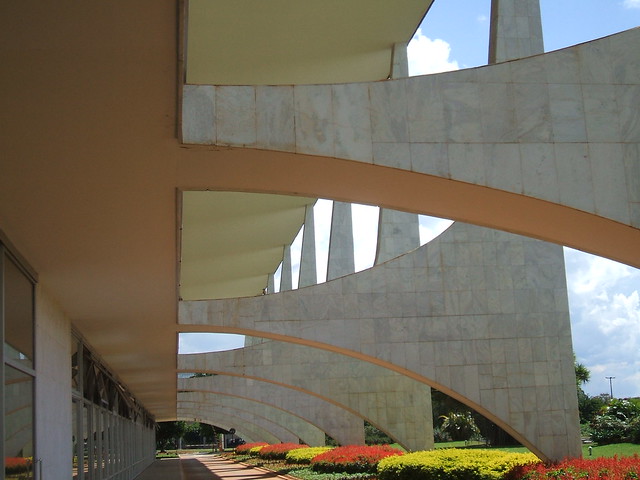- Timeless design principles can unify the communityThe responsibility for the safety of a community during an earthquake or any other natural disaster extends well beyond the architect. Regardless of his skills and ethics, when the client and general community refuses to do what is necessary to ensure safety during a disaster, coming catastrophes are sure to take human lives. In our built communities we have often ignored classic design principles necessary for seismic issues. Often the means are simple and cheap but are not utilized simply because they aren't pretty or convenient to the program.
Increasingly, we build isolated structures with little seismic design intent that fail during earthquakes, and disorganized rescuers fail to save lives. When we overcome these struggles, however, we benefit with much more than just safe buildings. The community will have unified for a common cause.
Organization and connectivity often makes the difference. A community with disaster management programs and proper regulations will ensure the rights steps are taken. This approach, cooperation between nations and communities as well as more oversight and regulation in the entire build-design industry, will properly motivate awareness throughout the design process, to earthquakes and other natural and man-made disasters.
With this organization, classic design principles may be implemented throughout the entire scope of design, on a public and individual level. An attitude of greater respect for timeless design principles will prevent overzealous design with new technology, and timeless architecture will unify the community.
Simple design principles can be utilized throughout the entire built environment design process. To reinforce these principles we need strategies that will build greater unity in a community, that will prevent damage and loss of life in a disaster.
A Disaster? The 1989 Loma Prieta earthquake was fun. I was only five at the time, but I remember it clearly. Through the chaos and strife, I recall excitement and the strange desire that earthquakes would happen more frequently. This was of course foolish because this earthquake killed people, but couldn't there be a way to experience the joys of seismic activities without the messy cleanup, without the suffering?
We tend to get caught up with the introduction of new technology, technology we can't yet handle. Even ideal buildings from geniuses like LeCorbusier fall to catastrophic earthquakes because they aren't designed for earthquakes. Too often we either forget or ignore simple design principles that have been around for thousands of years. San Francisco had had a large catastrophic earthquake from which they should have learned their lessons. But the later Loma Prieta earthquake caused human suffering.
Designers are less likely to go the extra mile, to learn seismic strategies and to employ them, unless someone steps up and starts the trend, and this burden falls on the architect. But the architect is powerless unless there is some sort of public awareness or government regulation. The architect must therefore seek more government intervention and must show that there are greater benefits than mere insurance in the case of an unlikely seismic event.
Great architecture doesn't battle natural forces but channels them to positive uses. Interestingly, civilizations in history have considered earthquakes rather positively. Why should we feel threatened by a planet that constantly sustains our lives and gives us happiness? The earth's shaking reveals it as an animated entity, and as humans try to explain this phenomena, life is assumed.
Most religions have associated earthquakes with the presence of God.
[1] The Greeks thought Poseidon caused earthquakes. Norse mythology taught that Loki, bound in a cave, caused earthquakes. Christianity teaches that earthquakes herald the presence of God's coming. Hindus, Zapotec, Jewish, and Maimas likewise associate seismic activity with the motion of a god. In a world of “relationships which are forever making cosmos out of chaos,”
[2] earthquakes are great universal gestures that rapport communities towards unity.
Principles of Earthquake Design City Renaissance designers developed archetypes sensitive to catastrophes by implementing height limitations, carefully shaping their typical floor-plans, and creating open urban spaces. The early open spaces were achieved with comprehensive environmental landscaping, and designers later widened roads and open urban spaces for greater response to disasters. Medieval cities had walls, protective envelopes, that may have been inconvenient but provided a host of benefits: protection from attackers, contained urban sprawl, and reinforcement for the general community of structures. The city envelope achieved “appropriate linkages, patterns, and forms which define a viable system”
[3] to deal with catastrophes.
Greater investment in city-wide protective programs can go a long way to solve a variety of problems. City programs must be considered for their potential contributions to disaster prevention and relief. A city's general infrastructure must consider all the natural features that indicate possible disasters and evaluate risks to determine zoning and code restrictions. Code regulations should set height limitations and restrict floor-plan shapes.
Site Building sites were carefully selected based on possible risks to the public and environmental risks to the building. The more important the building, the better site it got. Vitruvius devoted a good portion of his writings to site selection, with influences from wind, water features, soil type, and geographic features.
[4]This can be expanded with our new insight on earthquake waves and fault patterns. We can now “determine probabilistic distributions of occurrences with intensities”
[5] of seismic as well as wind loads. A city-wide program on behalf of designers could estimate the vulnerability of existing buildings and also consider geomorphology and geological risks of amplification. This would lead to better city configuration and aid designers of individual structures.
Building From city-wide elements to design for individual structures and components, Renaissance designers let structural solutions greatly influence their final configuration. Structural solutions to natural forces are often “considered a second level parameter which can be determinant only when linked to the architectural choice of making evident a structural aspect.”
[6] For example, Rem Koolhaas determined the configuration for the
Seattle library entirely based on the building's programs. The result is a lopsided building that seems entirely unsafe in an earthquake or any other disaster. Medieval buildings were symmetrical and compact, avoiding the awkward distribution of mass that we see in the
Seattle library. The amount of structure for the library is undoubtedly greater than it would need to be if the structural necessities were the first consideration. A final configuration primarily derived from structural solutions will decrease the amount of resistance and mitigation needed against natural forces.
New Solutions Also promoting greater honesty to natural forces, we recognize today the need for structures to deform in an earthquake. Rather than battling lateral forces, the much simpler solution is to just let it happen and prevent collapse or permanent deformation by using sophisticated moment-resisting frames.
Seismic isolation is another recent solution used more around the world, particularly in China were new urban construction is booming. Proper isolators can reduce the structure's acceleration response by one-eighth to one-half while reducing the cost of conventional seismic design by 13%. Isolators allow any kind of building shape and building type. Rubber bearing are most popular among the various types of isolators because they require less maintenance, they have vertical tension capabilities, they recover after the seismic event, and they are unaffected by temperature change. Chinese codes dictate which isolators are to be used based on how “important” the building is. For common civil buildings, horizontal forces must be decreased at least an eighth, while important buildings must have a decrease of at least a fourth.
[7] Recently, the “US Federal Emergency Management Agency adopted a performance-based seismic-resistant design approach” to seismic isolation.
[8] Performance-based design accounts for uncertainty in seismic hazards and building response, and seeks a certain performance criteria without exceeding or failing to reach this goal.
The isolators are built particular to the building's shape, the desired flexibility, the soil conditions, and the amount of vertical motion desired. The effect an earthquake has on a building can thus be mitigated without simply preventing or blindly battling against the forces.
Cooperation These principles cannot be applied throughout the entire design spectrum, from city design to building components, without widespread cooperation. The California Seismic Safety Commission said architects are “in a crucial position to influence the seismic safety of structures” because of their “overall view of all aspects of the design and construction process.” It's the architect's responsibility to work with the community, to peer review other projects, to provide education programs for the public, and to evaluate damaged buildings.
[9] But the architect is powerless unless the client feels some kind of pressure, either from insurance companies, from government regulations, or from safety concern for the occupants. It is therefore essential that the public be educated on the threats of natural disasters, and that the government take a stronger role in code regulations and safety programs.
Inter-government Since the China-US Millennium Symposium on Earthquake Engineering in November 2000, there has been great cooperation between America and Asia in earthquake design. In the past, cooperation has been difficult because of the distance between these countries, but improvements in digital communication have helped this collaboration.
Multinational research has been more fruitful than when countries go it alone, and a larger number of people can be helped. More protocols and inter-university projects would cement common cooperation between countries on the pacific rim. In this symposium, both countries recognized that the greatest challenges to modern earthquake design is cooperation, public education, and increasingly ambitious building projects.
[10]) Emphasis has been placed on the need for a general digital network that can be accessed by the general public.
The 2004 Thailand tsunami disaster was shameful. We now have capabilities to detect seismic activity as soon as it happens and warn people before they are effected, a “Digital Disaster Reduction System.” It is in everyone's best interest to establish an international detection and warning system to prevent damage from world catastrophes. With such a system we can also have greater insight in fault activities and tenancies to help local design, developing catastrophic classification maps, and so forth.
The Pacific Earthquake Engineering Research Center can establish a desired performance criteria for a region that will dictate the urban design there. With such a system in place, it would be much easier for the designer to develop seismic designs. It is simply a matter of implementing these “simple prescriptive procedures.”
[10]Inter-community Lifelines are the top priority for societies: water, power, gas, etc. These should be the priority for regions and communities. Each community needs a central agency to monitor and inspect all lifelines. This agency would identify hazards to networks, inventory the networks, determine vulnerabilities, implement mitigation measures, and prepare a response model for all anticipated disasters.
To help manage large systems, these networks could be broken down into “cells,” each with their monitoring agency. To help in this response plan, “digital community models” for each cell will make identification of issues, communication, and aid easier in the case of a disaster.
[11] All agencies inside the regional disaster management system must seek holistic solutions for all kinds of disasters, terrorism, wind, fire, flooding, etc., to ensure preventive measures that enforce and don't diminish prevention of other disasters.
The communities' lifelines should be redundantly interconnected, so that if one community's lifeline should fail it has a backup. The result would be “appropriate linkages, patterns, and forms which define a viable system”
[3] much like medieval city infrastructures.
Again, the structure necessities of this architectural system should be the primary exigencies for settlement patterns and archetypes within communities. For example, construction atop precarious ridges should be discouraged even though they may have a nice view. This sounds reasonable enough, but getting people to actually build intelligently is a difficult matter.
There are inevitably building types that will that fall out of this criteria, and these buildings are especially at high risk- buildings such as rehabilitation projections, areas of renovation and densification (new housing), intense urbanization, and urban sprawl. Regional and local regulations should therefore discourage these kinds of settlements, and disaster agencies should consider special preventive and relief measures in these areas.
The three biggest challenges to developing this system are (a) Inter-institutional and inter-disciplinary coordination, (b) Private-Public sector Collaboration, and (c) Development of susceptibility risk maps.
[11] To make inter-institutional coordination easier, each disaster agency should be restructured into a hierarchal order, from national to regional and community down to cells. The kind of legal squabbling that caused so much damage in last year's Lake Tahoe fire can be prevented by establishing a decisive leader over all disciples on each level. Greater clarity in information over the proposed international digital network would help insurance agencies and other private sector establishments provide pressure for seismically safe communities.
Government departments need access to the disaster network to provide pertinent information and to receive helpful information that save lives. If each community is responsible for precise mapping and each of their maps is added up into an overall map, FEMA could develop much better maps for the general public. Besides the typical seismic hazard map, there should be local vulnerability maps, direct maps (population in regards to physical elements of the city), and functional maps (population in regards to their activities.)
[11] This kind of coordination is the most important design measure for dealing with disasters. After all, natural and man-made disasters are the main reason mankind built cities in the first place. Disasters bring people together for prevention, endurance, and relief. Earthquakes are especial in that they are broad events that they hit a large amount of people much the same way. They challenge our beliefs of gravity and solid foundations, and spur us to build a more solid groundwork. These fundamental designs are likewise broad and for the greater good. Broad communication between civilizations and communities can help with research that will save lives during an event.
We have lost essential design attitudes for preserving life and safety in our structures and for civilization in general. Structure necessities should come first in considering configuration. Structures and human activities should work with natural forces rather than blindly battling them. Most importantly, coordination should be a means of disaster prevention and relief. From international communication to building component design, these mantras should be common in architectural language and public knowledge.
Earthquakes don't have to be disasters if they harmlessly bring the community towards unity with each other and with the natural landscape. New technology offers better solutions to the issues, and if we don't lose sight of those fundamental mantras, they can make the designs cheaper and more reliable.
More ambitious expeditious projects and quick acceleration in technological development are challenges, but with greater governmental intervention each designer involved can hold his responsibility. America's tendency toward thoughtless pragmatism can be reversed.
References^ERI University of Memphis, “Earthquake Myths and Folklore” 2008 http://www.ceri.memphis.edu^Mordecai M. Kaplan, “The Meaning of God in Modern Jewish Religion” 1995^JAE, Vol. 33, No. 4, “Urban Design and Hazards” by Henry J. Lagorio On behalf of Association of Collegiate Schools of Architecture, Inc. 15 August, 2006 Summer 1980^See Vitruvius' “Ten Books on Architecture”^Applied Mathematics and Mechanics Volume 27, Number 5, “Probability model and
solution on earthquake effects combination in along wind resistant design of tall-flexible buildings” by Hong Xiao-jian and GuMin May, 2006^M.Mezzi and A. Parducci “Conceptual Seismic Design and State-of-the-Art Protection Systems for Consortium of Universities for Research in Earthquake Engineering” http://www.curee.org^Fu Lin Zhou, Zheng Yang, Xiang Yun Huang, Ping Tan “Research and Application on Different
Types of Seismic Isolation Structures in China” http://3icee.njut.edu.cn^Rafael Sabelli, Stephen Mahin, Chunho Chang, “Seismic Demands on Steel Braced Frame
Buildings with Buckling-Restrained Braces” http://nisee.berkeley.edu^State of California Seismic Safety Commission “Architectural Practice and Earthquake
Hazards (Committee on the Architect's Role in Earthquake Hazard Mitigation)”(2008)^B.F.Spencer, Y.X. Hu “Earthquake Engineering Frontiers in the New Millennium” 2001 ^U. S. Conference on Lifeline Earthquake Engineering, James E. Beavers “Advancing
Mitigation Technologies and Disaster Response for Lifeline Systems” 2003^Nora Elsa Nacif, María del Pilar Espinosa and Dora Roitman de Schableman “Seismic
Prevention and Urban Development” http://wwww.crid.or.cr (1996)

 torah bright
torah bright torah bright
torah bright In 2007, Bright took first at the Nissan X-Trail Nippon Open in the women’s halfpipe, giving her back-to-back wins in two consecutive competitions. At the 2007 World Super Pipe Championships in Park City, Utah, Bright won first place, beating 2002 Olympic gold medalist Kelly Clark. In late 2007, she made the podium for both events in the Roxy Chicken Jam, the final event in the TTR (Ticket to Ride) Snowboard Tour, where she became the 2007 TTR world champion.
In 2007, Bright took first at the Nissan X-Trail Nippon Open in the women’s halfpipe, giving her back-to-back wins in two consecutive competitions. At the 2007 World Super Pipe Championships in Park City, Utah, Bright won first place, beating 2002 Olympic gold medalist Kelly Clark. In late 2007, she made the podium for both events in the Roxy Chicken Jam, the final event in the TTR (Ticket to Ride) Snowboard Tour, where she became the 2007 TTR world champion.%20Stadler.jpg) torah bright snowboarder australian
torah bright snowboarder australian torah bright snowboarder australian
torah bright snowboarder australian















































